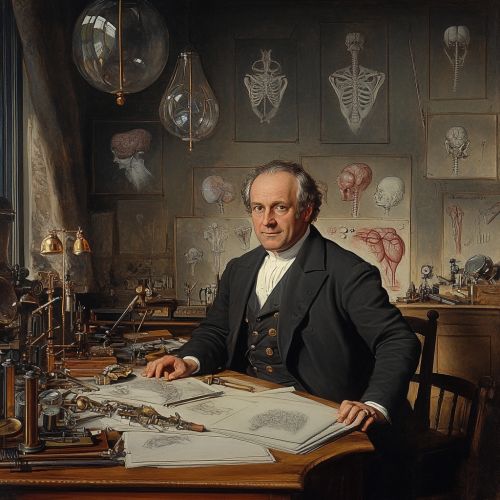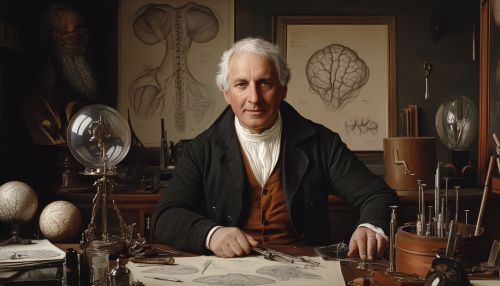Johannes Peter Müller
Early Life and Education
Johannes Peter Müller was born on July 14, 1801, in Koblenz, Germany. He was the son of a shoemaker and grew up in modest circumstances. Despite the financial constraints, Müller exhibited a keen interest in the natural sciences from an early age. He attended the Gymnasium in Koblenz, where he received a classical education that laid the foundation for his future scientific endeavors.
In 1819, Müller began his medical studies at the University of Bonn. His academic journey was marked by a profound dedication to the study of anatomy and physiology. Under the mentorship of prominent scholars such as Karl Asmund Rudolphi and Johann Friedrich Meckel, Müller honed his skills and developed a deep understanding of the human body. He later transferred to the University of Berlin, where he completed his medical degree in 1822.
Academic Career
After obtaining his degree, Müller embarked on an academic career that would establish him as a leading figure in the field of physiology. In 1824, he was appointed as a Privatdozent (private lecturer) at the University of Bonn. His lectures on comparative anatomy and physiology attracted a significant number of students, and his reputation as an educator grew rapidly.
In 1830, Müller was appointed as a full professor of anatomy and physiology at the University of Bonn. During this period, he conducted extensive research on the anatomy of various animal species, contributing to the understanding of comparative anatomy. His work laid the groundwork for future studies in evolutionary biology and the classification of organisms.
Contributions to Physiology
Müller's contributions to physiology were groundbreaking and multifaceted. One of his most significant achievements was the formulation of the Law of Specific Nerve Energies. This principle, which he proposed in 1826, posits that each sensory nerve is responsible for transmitting a specific type of sensation, regardless of the nature of the stimulus. This concept revolutionized the understanding of sensory perception and paved the way for future research in neurophysiology.
In 1833, Müller published his seminal work, "Handbuch der Physiologie des Menschen für Vorlesungen" (Handbook of Human Physiology for Lectures). This comprehensive text synthesized existing knowledge and introduced new insights into the functioning of the human body. It became a standard reference for medical students and researchers and solidified Müller's reputation as a leading physiologist.


Research on the Nervous System
Müller's research on the nervous system extended beyond the Law of Specific Nerve Energies. He conducted pioneering studies on the reflex arc, elucidating the pathways through which sensory information is transmitted to the central nervous system and motor responses are generated. His experiments demonstrated the importance of the spinal cord in mediating reflex actions, a discovery that had profound implications for the understanding of nervous system function.
In addition to his work on reflexes, Müller investigated the mechanisms of neural conduction and the properties of nerve fibers. He was among the first to describe the phenomenon of saltatory conduction, where nerve impulses jump between nodes of Ranvier along myelinated axons. This discovery provided critical insights into the efficiency and speed of neural communication.
Contributions to Comparative Anatomy
Müller's interest in comparative anatomy led to significant contributions in the classification and understanding of various animal species. He conducted detailed studies on the anatomy of fish, amphibians, reptiles, birds, and mammals, comparing their structures and identifying homologous features. His work in this area was instrumental in advancing the field of systematics and contributed to the development of evolutionary theory.
One of Müller's notable achievements in comparative anatomy was his research on the branchial arches of vertebrates. He demonstrated that these structures, which are present in the embryonic stages of all vertebrates, give rise to various anatomical features such as gills in fish and the jaw and ear bones in mammals. This finding provided crucial evidence for the concept of homology and supported the idea of common ancestry among vertebrates.
Influence on Evolutionary Biology
Although Müller did not explicitly propose an evolutionary theory, his work laid the foundation for future developments in the field. His comparative anatomical studies provided evidence for the continuity and transformation of anatomical structures across different species. This concept of morphological continuity was later incorporated into the theory of evolution by natural selection, as proposed by Charles Darwin.
Müller's research on embryology also contributed to the understanding of evolutionary processes. He observed that the embryonic development of different species exhibited similar stages, a phenomenon known as ontogeny. This observation supported the idea that embryonic development recapitulates the evolutionary history of a species, a concept later formalized as the biogenetic law by Ernst Haeckel.
Legacy and Honors
Johannes Peter Müller's contributions to science were widely recognized during his lifetime. He was elected to numerous scientific societies, including the Royal Society of London and the French Academy of Sciences. In 1840, he was awarded the prestigious Copley Medal by the Royal Society for his outstanding contributions to physiology and anatomy.
Müller's influence extended beyond his own research. He mentored a generation of scientists who would go on to make significant contributions to various fields. Notable among his students were Theodor Schwann, who co-founded the cell theory, and Hermann von Helmholtz, who made groundbreaking discoveries in physiology and physics.
Personal Life and Death
Despite his demanding academic career, Müller maintained a balanced personal life. He married his cousin, Sophie Müller, in 1832, and the couple had several children. Müller was known for his modesty and dedication to his family, often spending his leisure time engaged in outdoor activities such as hiking and gardening.
Johannes Peter Müller passed away on April 28, 1858, in Berlin, Germany. His death marked the end of a prolific career that had a lasting impact on the fields of physiology, anatomy, and evolutionary biology. Müller's legacy continues to be celebrated in the scientific community, and his contributions remain foundational to the understanding of the human body and the natural world.
